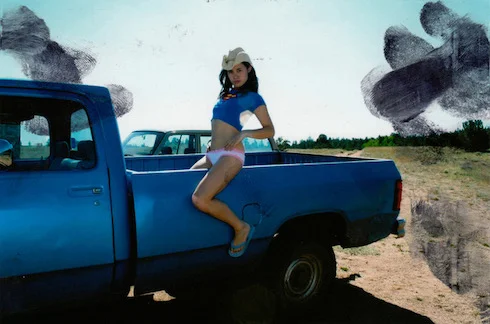A Dangerous Walk: Interview with Signe Pierce
Signe Pierce. Self Portrait.
Lara Pan: My first encounter with your work was American Reflexxx, where you walk up and down Myrtle Beach wearing a minidress, heels, and a reflective mask. The reactions get pretty intense –– they question your gender, they yell slurs, one woman even pushes you to the ground. Did you anticipate this? Were you prepared to take these risks for a performance?
Signe Pierce: Allí Coates and I made the film American Reflexxx together in the Summer of 2013 in Myrtle Beach, South Carolina. We expected there would be catcalling and general playfulness, but the violence was absolutely shocking and the questions about my gender were unexpected. My perceived gender ambiguity ended up becoming a major part of this piece. I’ve had a mantra, ever since I was in art school, that “I’ll do anything for art.”. The reactions started getting increasingly violent, and I was like, “This is what’s happening right now and this is what’s meant to happen.”
Lara: For me, your performance in American Reflexxx reads like a physical manifestation of the principles of cyberfeminism. Do you think there’s a relationship between the violent reactions during the physical performance and to the ideas themselves? How do you explain this violence in the 21st century when we have so many more open dialogues about these topics?
Signe: Yes, I definitely do. There’s something scary because you see this robot woman who is commanding her own identity, but she’s in this sexy feminine form that we associate with hyper-sexualized woman all the time on TV, in porn. The cyborg has a certain strength to transcend biology. People saw this porn star walking down the street, but she’s wearing this cold austere shield. You can’t read her expression, and this created a fear of the “other”. There is a time and a place for being aggressive, but we need to be willing to learn and unlearn.
Lara: I love your distorted selfie series. The elements remind me of a 70s softcore kitsch aesthetic—the soft warm lighting, palm fronds, satin sheets. Where does this come from and what is your vision for your photographic practice?
Signe: I had spent a lot of time thinking about how I was raised. I spent my formative years in southern California surrounded by beach babes, MTV, and these highly idealized versions of femininity. Identity and sexuality are such major roots of who we are as people, and so much of it is being tinkered with by the selective exports of media and Hollywood. I decided to shoot myself in the style of a classic centerfold, which is typically photographed for male consumption. It was like, “I’m going to photograph myself playing up this hypersexualized femme.” I got my hair done, I got my nails done, I got a tan. I did the things that a playmate would do in preparation for a big shoot, but I shot myself in this warped mirror to reflect my own identity and literalized the warped elements of perception that play into ideas of what is sexy, feminine, gender, and identity.
This interview has been condensed and edited. To learn more about Signe Pierce, check out our latest issue RISK.
Signe Pierce. Performance.









